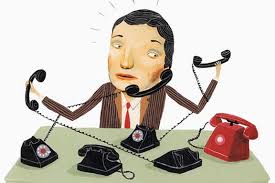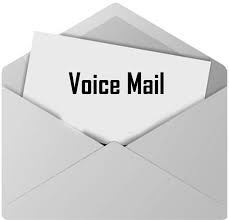For what?—is the appropriate response.
 Over the years, I have participated in LinkedIn Group conversations in response to the above question. It comes up again at least once a year and has always generated some interesting answers.
Over the years, I have participated in LinkedIn Group conversations in response to the above question. It comes up again at least once a year and has always generated some interesting answers.
For instance, there have been well thought out answers that have named LinkedIn as the only source they use. Establish the relationship, they say, and then get someone to introduce you. You know what? Makes sense to me.
There are those that say email works as no one answers their phone any more. And then there are the ones that say, I always just stop by and try to get in to see them face-to-face. The majority still use the phone, because we have become so inundated with email, that no one pays any attention to that…
Then there are those that say it depends, or that they use a combination. Well, I fall into the latter category. None of them work all of the time, and none of them fail all of the time. I wrote a blog a while back that talked about how much research one should do before calling a target. This is a lot like that. Here’s my take based on the following assumption:
Primary Assumption: Our goal is an Initial Appointment with a decision maker. It is also worth our while to have done the research as I laid out in the blog above. Finally, the decision maker is a high level individual (see blog again).
And then here are my thoughts on each of the approaches:
LinkedIn Pros: If you are calling high, LinkedIn makes a lot of sense. If you can get an introduction, you’ll get a much quicker and open minded response from your target. LinkedIn will also work well with people that have a lot of contacts. If they don’t, LinkedIn doesn’t carry a lot of weight with them. If that is the case, have the introduction made via phone and/or email, or at least, in conjunction with LinkedIn.
LinkedIn Cons: The biggest drawback of this approach is that it takes a long time and a lot of effort (both calendar time and hours of effort) to establish credibility with the person that will be providing you with the introduction. It may even take an introduction from one person you know to another you don’t in order to get the introduction to the one you wish to meet. Good quality introductions come from people who can vouch for your integrity, knowledge, and in some cases the validity of what you sell. We must now make the first introduction comfortable with us so that they will be comfortable making the second introduction (to the one we wish to meet with). All of that takes time and lots of it.
The second drawback is that not everyone we want to meet with is on LinkedIn. Contrary to popular belief, all executives are not on LinkedIn as they know it has become a great prospecting tool for sales professionals.
By the way, if you do use LinkedIn for the final introduction, have your friend (new or old) make the introduction, regardless of whether it is made within the LinkedIn platform or some other method. The old, “So and so, suggested that we meet” doesn’t work near as well—hence, LinkedIn, eh?
Email Pros: One advantage of sending emails is that it is quick and the majority of your effort can be done during non-selling hours regardless of whether they are delivered during business hours or not—I recommend that they are. Some people check their email during their non-business hours so it also expands your selling efforts beyond the normal working day. Some people just don’t answer their phone and respond better via email.
Email Cons: For this blog, I went back and averaged out the number of emails I get per day as a CEO of two different companies. Trust me, it is over 250. My spam filter averaged 178 per day alone over the past five business days. I must go through all of those because even my spam filter catches a good email gets caught in there. All I look at is the subject line, the address of who sent the email, and what country it originated from. Even the ones from the U.S. (I totally ignore those from the Ukraine, Nigeria, India, etc.), I secondarily look for company domain names, so if you are using a Yahoo or a Gmail domain name and you are selling to executives in a B2B environment, don’t even waste your time.
Another disadvantage of using email to set appointments is that it is much easier to say no in an email than it is during a conversation. When you attempt to counter their reason for saying no, you’ll have to do it via email and they may never even read it (most likely occurrence).
The point is, some executives aren’t going to look through their email closely enough for it to be the only way you try to set appointments.
Phone Pros: Once you get someone on the phone, the phone gives us the ability to use two of the three mediums humans use to effectively communicate, according to a UCLA study: tonality and content. Tonality consists of 38 percent of the way we communicate and content 7 percent. The other 55 percent is body language and facial expression reading. That does not exist in any of the three—obviously.
The phone also gives us the ability to immediately correct misconceptions or misunderstandings that the written word does not. It also provides the opportunity to apply our selling skills when the target says no while they are on the phone.
Phone Cons: Some people don’t answer their phones very often. Some have gatekeepers and some just use voicemail to screen calls.
The biggest disadvantage is many sales professionals don’t know how to leave good voicemails (along with accompanying emails), get through gatekeepers or know how to handle the different flavors of no they hear—so they simply don’t make the calls. It can be a discouraging way to spend part of your selling day if you don’t have a well thought out process, the skills to do it, and a tool designed to make the process easier and faster.
Canvassing Pros: First of all, canvassing doesn’t fit most selling models. But if it does, the biggest advantage of canvassing is that you get a chance to see the facilities and get a feel for the business before talking to the target. The second advantage is that it can be done in conjunction with sales calls on your calendar. You’re already in the area, right?
A third advantage is that if you sell a horizontal solution (everybody uses it) you’ll find businesses that won’t show up on purchased lists.
Canvassing Cons: The biggest disadvantage of canvassing is that it takes so much time. We did a study a few years back measuring the time it takes to make a canvass call versus a phone call. The difference was enormous. There just aren’t enough hours in the day for most sales professionals. Secondly, if you do get in to see the target, tell them the reason you stopped by was to set an appointment—unless they have the time to meet then (and then you must be specific as to how much time you need). If you make that call the Initial Appointment and don’t verify how much time you need, you’re at a disadvantage. Most sales professionals get nervous and change their Initial Appointment approach from that of an information gatherer to one of presentation hoping to hit upon a ‘need’. Most of those do not work.
If it makes sense for you to do it, I recommend the first call only is done face-to-face and the remainder of the attempts is done via phone/email.
Conclusion:
I believe that if it is worth doing the research to determine exactly why HERB (Highest Executive Responsible for Buying) would want to talk to me, then I am going to try to find a LinkedIn link to that individual. Then, I am going to use a combination of the phone and email to contact them to ask for an appointment.
Caponi Performance Group and Contact Science jointly market the telephone prospecting and cold calling solution called Coldcalling101™. It is the only comprehensive solution to solving the biggest barrier to success in most selling organizations—the inability to secure enough Initial Appointments to begin the selling process. We accomplish that through simultaneously addressing both the efficiency and effectiveness of the process. We can be reached at 817 224-9900 or at my You can also find answers to many of your challenges in our books: Contrary to Popular Belief, Cold Calling DOES Work! Volume I: Effectiveness, The Art of Appointment Making and Volume II: Efficiency, the Science of Appointment Making.
 The answer to the first question may seem pretty obvious when you think about it academically, but when you get into the ‘heat of battle’ and the receptionist asks if they can take a message, many just go with the flow and say “Sure!” Continue reading “Should I ask for voicemail or should I leave my message with the receptionist?”
The answer to the first question may seem pretty obvious when you think about it academically, but when you get into the ‘heat of battle’ and the receptionist asks if they can take a message, many just go with the flow and say “Sure!” Continue reading “Should I ask for voicemail or should I leave my message with the receptionist?” If you’re not familiar with our philosophy and approach to appointment setting, we are all about being as effective as we can on each call so we are as efficient as we can be over time in the process of pursuing many targets simultaneously. The reason is that very few of us have extra time to sit and make appointment setting calls, nor do many of us like doing it. Ergo, the fewer the dials we need to make and the less time we need to set aside to do it, the better.
If you’re not familiar with our philosophy and approach to appointment setting, we are all about being as effective as we can on each call so we are as efficient as we can be over time in the process of pursuing many targets simultaneously. The reason is that very few of us have extra time to sit and make appointment setting calls, nor do many of us like doing it. Ergo, the fewer the dials we need to make and the less time we need to set aside to do it, the better.  Our clients report that, in the B2B market space, the percentage of returned voicemails and emails has dropped over the past ten years with the advent of voicemail. Our experience mirrors that. So, the operative question is, “Should we stop leaving voicemails?” Our answer is an emphatic, “No!”, as our techniques have the percentage of returns on the rise again (over 10%), and as we pointed out in the blog covering
Our clients report that, in the B2B market space, the percentage of returned voicemails and emails has dropped over the past ten years with the advent of voicemail. Our experience mirrors that. So, the operative question is, “Should we stop leaving voicemails?” Our answer is an emphatic, “No!”, as our techniques have the percentage of returns on the rise again (over 10%), and as we pointed out in the blog covering  As you know, we recommend sending along a complementary email to support voicemails we leave. The result of doing this has tripled the responses we (and our clients) are now getting from placed calls, so it is worth doing (particularly if it takes no effort to send the emails like we recommend).
As you know, we recommend sending along a complementary email to support voicemails we leave. The result of doing this has tripled the responses we (and our clients) are now getting from placed calls, so it is worth doing (particularly if it takes no effort to send the emails like we recommend).  Over the years, I have participated in LinkedIn Group conversations in response to the above question. It comes up again at least once a year and has always generated some interesting answers.
Over the years, I have participated in LinkedIn Group conversations in response to the above question. It comes up again at least once a year and has always generated some interesting answers. Now that I’ve got your attention, let me lead with a caveat. Most voicemails and emails do not get returned these days. Ten years ago, we averaged 22% of our voicemails returned. I refer to that as the pre-voicemail era. Two years ago it was closer to a disappointing 3%, and now it’s back up to a more reasonable 10% including emails returned.
Now that I’ve got your attention, let me lead with a caveat. Most voicemails and emails do not get returned these days. Ten years ago, we averaged 22% of our voicemails returned. I refer to that as the pre-voicemail era. Two years ago it was closer to a disappointing 3%, and now it’s back up to a more reasonable 10% including emails returned.